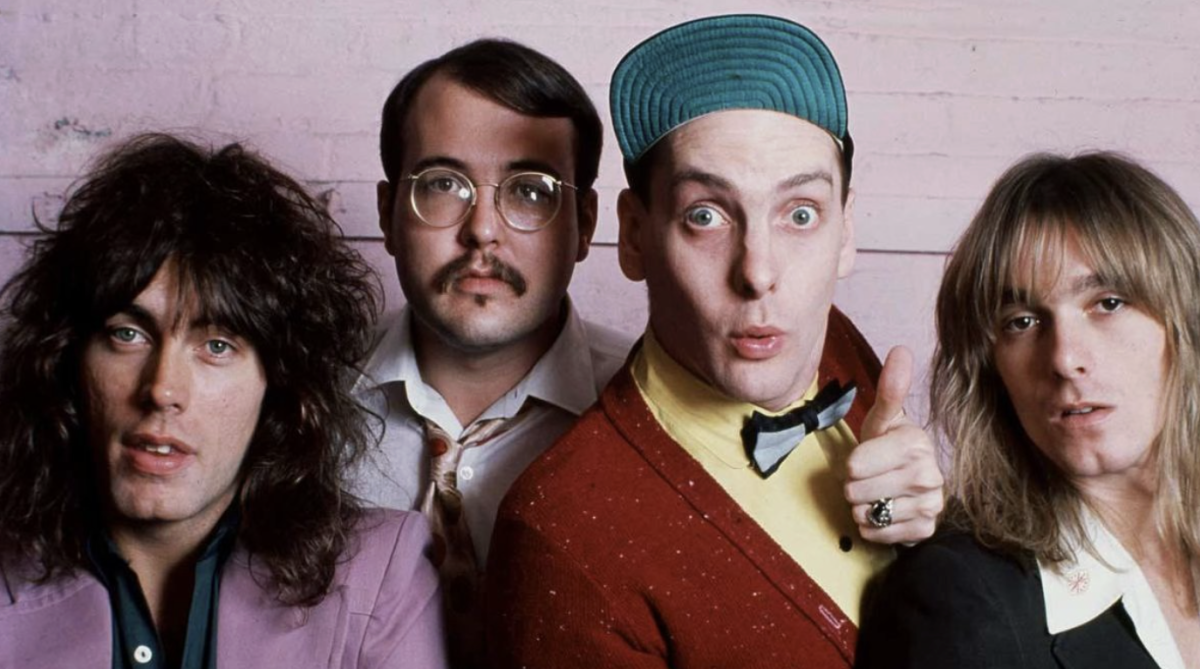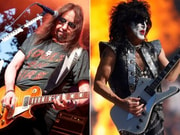
The crowd noise is so deafening you can barely make out Robin Zander's words. Thousands of Japanese fans are screaming with Beatlemania-level hysteria as the Cheap Trick frontman steps to the microphone on that fateful spring night in 1978. "And this next song is called 'I Want You...,'" he says slowly, pointing to himself with theatrical flair, "to Want Me."
What happened next would transform four guys from Rockford, Illinois into rock legends.
It would turn a throwaway pop parody into their signature anthem and prove that sometimes the best things in life really do happen by accident.
The sacred stage that changed everything
The venue itself was part of the magic.
The Nippon Budokan was built in 1964 for the Summer Olympics, originally designed for judo events.
When the Beatles were booked to play there in 1966, there was a controversy, as critics argued that rock music was an affront to traditional Japanese values.
By the late 1970s, however, Budokan had become the Carnegie Hall of rock venues in Japan, where legends like Led Zeppelin and Deep Purple had left their mark.
For Cheap Trick, playing Budokan was both an honor and a lifeline.
While they'd been grinding it out as opening acts for major bands back home, barely making a dent in American radio, something magical had happened across the Pacific.
Japanese fans had embraced them with the kind of fervor usually reserved for, well, the Beatles.
On April 28 and 30, 1978, they recorded their performances at the Nippon Budokan with an audience of 12,000 screaming Japanese fans nearly drowning out the band at times.
The energy was so intense that you can still feel it crackling through the recordings nearly five decades later.
How a pop joke became power pop perfection
The story of "I Want You to Want Me" begins not with artistic inspiration, but with Rick Nielsen's sense of humor.
The Cheap Trick guitarist had written it as a deliberately silly response to the disco and ABBA-style pop dominating radio in 1977.
As Tom Petersson recalled, Nielsen's attitude was essentially, "I'm just going to do an over-the-top pop song. I just want to do one that's so silly—total pop—and then we'll do a heavy version of it."
Nielsen himself was refreshingly honest about his creation: "It was the easiest lyric I could think of. It was just as bad as all the other songs that were out at the time."
The original studio version on their 1977 album "In Color" proved his point—it flopped completely, failing to chart anywhere in the United States.
But here's where the magic of live performance comes in.
What sounded lightweight and forgettable in the studio transformed into something urgent and electric when played for those screaming Japanese fans.
The band members fed off the crowd's energy, and suddenly Nielsen's pop parody became a power pop masterpiece.
The night that almost didn't happen
Here's the twist that makes this story even more incredible: "I Want You to Want Me" wasn't even supposed to be performed that night.
As Robin Zander later explained, "We had played that song over the first couple of years live, in clubs and stuff, and it got kind of an 'Ehhh, okay' response. We didn't do it every night or anything."
About fifteen minutes before showtime, their manager approached them with urgent news.
The Japanese production team said their set wasn't long enough—they needed another song.
Someone suggested dusting off "I Want You to Want Me," and that last-minute decision changed everything.
"I probably wrote it in about five minutes, and now it's been around for ages. Everybody kind of knows it, and it makes people happy."
The crowd's reaction was immediate and overwhelming.
They knew every word, sang along with religious fervor, and turned what had been a throwaway track into the emotional climax of the show.
The Japanese fans didn't just sing along—they became part of the band, their voices creating a wall of sound that elevated the performance to legendary status.
When bootlegs became big business
The album was initially intended for release only in Japan in October 1978, but strong airplay and tens of thousands of import copies sold in the United States forced Epic Records to release it domestically in February 1979.
American rock fans were hungry for this energy, and word of mouth spread like wildfire.
The results were staggering.
The album peaked at number four on the Billboard 200 and became the group's best-selling album with over three million copies sold.
The single "I Want You to Want Me" reached number seven on the Billboard Hot 100 chart, giving the band their long-awaited breakthrough hit.
From power pop to grunge godfather
The influence of that Budokan performance rippled through decades of rock music.
Kurt Cobain of Nirvana later told the press, "We sound just like Cheap Trick, only the guitars are louder."
The raw energy and crowd participation captured on the album became a template for live rock records, proving that sometimes imperfection creates more magic than polish.
Chart Success Story
Cheap Trick at Budokan peaked at #4 on the Billboard 200, while "I Want You to Want Me" reached #7 on the Hot 100—their biggest hit single.
The single was certified gold by the RIAA, representing sales of one million records.
In Canada, it performed even better, hitting #2 and staying there for two weeks.
The album's cultural significance has only grown with time.
In 2019, it was selected by the Library of Congress for preservation in the United States National Recording Registry for being "culturally, historically, or aesthetically significant."
Classic Rock critic Malcolm Dome rated it as Cheap Trick's greatest song, noting the irony: "Conceived by Nielsen as an overblown pop parody, it's become a true pop rock classic."
The difference between studio polish and live magic
What made the Budokan version so special compared to the original studio recording? Everything.
The studio version had what critics called "lightweight production" and a country-tinged honky-tonk feel that completely missed the mark.
The live version was pure electricity—faster, harder, and infinitely more engaging.
The crowd participation became legendary.
Where the studio version used an echo effect on the "cryin', cryin', cryin'" part, the Japanese audience naturally provided their own echo, chanting along with perfect timing.
It was rock and roll call-and-response at its most joyful and spontaneous.
Lessons from an accidental masterpiece
The story of "I Want You to Want Me" offers several fascinating insights into how music history is made.
First, sometimes your throwaway ideas become your greatest successes.
Nielsen genuinely thought he was writing disposable pop fluff, yet it became the song that put his kids through college.
Second, the power of live performance cannot be overstated.
The same song that died a quiet death as a studio recording became pure magic when filtered through the energy of a live crowd.
There's something about the connection between performer and audience that can transform even the simplest material into something transcendent.
Finally, timing matters.
The song might never have happened without that last-minute panic about set length.
Sometimes the best moments in life—and in rock and roll—come from happy accidents and split-second decisions.
Did you know?
Did you know?
The Beatles' connection to Budokan created a perfect parallel—both bands faced controversy for performing at the "sacred" venue, and both left with career-defining live recordings. The venue's transformation from Olympic judo hall to rock temple mirrors how "I Want You to Want Me" evolved from pop parody to power pop classic.
The song that keeps on giving
Nearly fifty years later, "I Want You to Want Me" remains a staple of classic rock radio and a song that instantly transports listeners back to that magical night in Tokyo.
It's been covered by everyone from Letters to Cleo to Pomplamoose, proving its enduring appeal across generations and genres.
For those who lived through the late 1970s, the song represents something special—a moment when pure rock and roll energy trumped corporate calculation, when a band's genuine connection with their fans created something more powerful than any marketing campaign could manufacture.
The accidental masterpiece formula
- Sometimes your "worst" ideas become your biggest hits
- Live performance can completely transform a song's impact
- Authentic crowd energy beats studio perfection every time
- Cultural timing and unexpected opportunities matter as much as talent
- The best rock and roll moments often come from happy accidents
What This Means For You
The next time you hear Robin Zander's voice cutting through that wall of screaming fans, remember that you're listening to one of rock history's greatest happy accidents.
A song written as a joke, performed as an afterthought, and released as an accident became the breakthrough that launched a legendary career.
What's your favorite "accidental hit"—a song that became famous in ways its creators never expected? Share your thoughts in the comments below, and let's celebrate the beautiful unpredictability of rock and roll history.
Primary Source
https://www.aol.com/articles/iconic-70s-rock-band-breakout-213215910.html
Cheap Trick Perform “I Want You to Want Me” Live at Budokan
Cited text: The Nippon Budokan, the venue in which this song and the album off of which it comes was recorded, was built in 1964 for the Summer Olympics, and for ...
Excerpt: The Nippon Budokan was built in 1964 for the Summer Olympics, originally designed for judo events
https://thedeletebin.com/2008/11/12/cheap-trick-perform-i-want-you-to-want-me-live-at-budokan/
Cheap Trick Perform “I Want You to Want Me” Live at Budokan
Cited text: When the Beatles were booked to play there in 1966, there was a controversy. It was argued that four shaggy, bobbing heads and the sound of beat music...
Excerpt: When the Beatles were booked to play there in 1966, there was a controversy, as critics argued that rock music was an affront to traditional Japanese values
https://thedeletebin.com/2008/11/12/cheap-trick-perform-i-want-you-to-want-me-live-at-budokan/
Cheap Trick at Budokan - Wikipedia
Cited text: Cheap Trick found early success in Japan, and capitalized on this popularity by recording Cheap Trick at Budokan at the Nippon Budokan in Tokyo on Apr...
Excerpt: On April 28 and 30, 1978, they recorded their performances at the Nippon Budokan with an audience of 12,000 screaming Japanese fans nearly drowning out the band at times
https://en.wikipedia.org/wiki/Cheap_Trick_at_Budokan
Cheap Trick at Budokan - Wikipedia
Cited text: Recorded at the Nippon Budokan in Tokyo, the album was first released in Japan on October 8, 1978, and later released in the United States in February...
Excerpt: The album was initially intended for release only in Japan in October 1978, but strong airplay and an estimated 30,000 import copies sold in the United States forced Epic Records to release it domestically in February 1979
https://en.wikipedia.org/wiki/Cheap_Trick_at_Budokan
Cheap Trick at Budokan - Wikipedia
Cited text: The album was intended for release only in Japan but with strong airplay of the promotional album From Tokyo to You, an estimated 30,000 import copies...
Excerpt: The album was initially intended for release only in Japan in October 1978, but strong airplay and an estimated 30,000 import copies sold in the United States forced Epic Records to release it domestically in February 1979
https://en.wikipedia.org/wiki/Cheap_Trick_at_Budokan
Cheap Trick at Budokan - Wikipedia
Cited text: In the U.S., the album peaked at number four on the Billboard 200 and became the group's best selling album with over three million copies sold.
Excerpt: The album peaked at number four on the Billboard 200 and became the group's best-selling album with over three million copies sold
https://en.wikipedia.org/wiki/Cheap_Trick_at_Budokan
Cheap Trick at Budokan - Wikipedia
Cited text: The single "I Want You to Want Me" reached number seven on the Billboard Hot 100 chart.
Excerpt: The single "I Want You to Want Me" reached number seven on the Billboard Hot 100 chart
https://en.wikipedia.org/wiki/Cheap_Trick_at_Budokan
Cheap Trick Perform “I Want You to Want Me” Live at Budokan
Cited text: Of Nirvana, Cobain told the press: “We sound just like Cheap Trick, only the guitars are louder…”.
Excerpt: Kurt Cobain of Nirvana later told the press: "We sound just like Cheap Trick, only the guitars are louder"
https://thedeletebin.com/2008/11/12/cheap-trick-perform-i-want-you-to-want-me-live-at-budokan/
I Want You to Want Me - Wikipedia
Cited text: It was certified gold by the Recording Industry Association of America, representing sales of one million records.
Excerpt: The single was certified gold by the RIAA, representing sales of one million records
https://en.wikipedia.org/wiki/I_Want_You_to_Want_Me
Cheap Trick at Budokan - Wikipedia
Cited text: In 2019, the album was selected by the Library of Congress for preservation in the United States National Recording Registry for being "culturally, hi...
Excerpt: In 2019, it was selected by the Library of Congress for preservation in the United States National Recording Registry for being "culturally, historically, or aesthetically significant"
https://en.wikipedia.org/wiki/Cheap_Trick_at_Budokan
I Want You to Want Me - Wikipedia
Cited text: Classic Rock critic Malcolm Dome rated it as Cheap Trick's greatest song, saying "conceived by Nielsen as an overblown pop parody, the irony is that i...
Excerpt: Classic Rock critic Malcolm Dome rated it as Cheap Trick's greatest song, noting the irony: "conceived by Nielsen as an overblown pop parody, it's become a true pop rock classic"
https://en.wikipedia.org/wiki/I_Want_You_to_Want_Me






